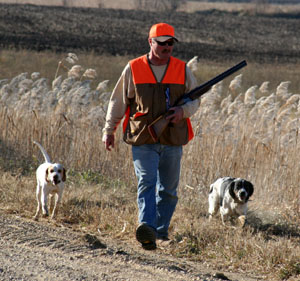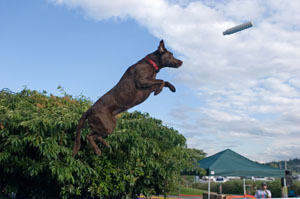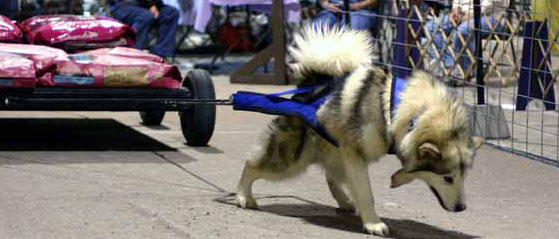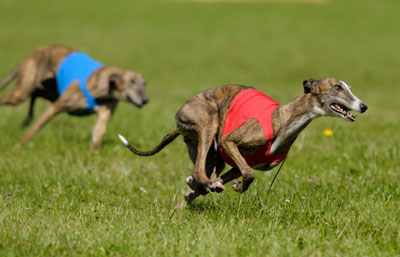Agility
Increasing speed, agility, and quickness of your dog is easier with an exercise regimen with the LaGuard K9 Fitness Vest. Short sprints and light weight exercises are best. Increases in strength, power, and acceleration can cause an increase in agility.
Hunting

A hunting dog refers to any dog that assists humans in hunting. There are several types of hunting dogs developed for the many tasks hunters require. The major categories of hunting dogs include hounds, terriers, curs type dogs, and gun dogs. Among these categories, further divisions can be made based upon the skill sets that the dogs possess.
Hunters may put a bell on the dog’s collar so that they can keep track of the dog. When the bell stops ringing that means the dog is on the point. Although various animals have been used to aid the hunter, none has been as important as the dog. Dogs today are used to find, chase and retrieve game and sometimes to kill it. Hunting dogs allow humans to pursue and kill prey that would otherwise be very difficult or dangerous to hunt.
Popular Hunting Dog Breeds
- Cocker Spaniels
- Collies
- Curs
- Coonhounds
- Deerhounds
- English Setters
- Feists
- Greyhounds
- Terriers
- Lurchers
- Pointers
- Poodles
- Retrievers
- Whippets
Suggested Exercises
- Stretching: encourage your dog to stand up on their rear legs and stretch their front legs upward against your chest to massage the muscles of their backs.
- Conditioning walk: be sure to travel different types of terrains.
- Running and jogging
- Swimming: a great exercise for dogs as it allows muscle actions and increases cardiovascular endurance without stressing the skeletal system.
Canine Disc

Divisions in Canine Disc dog events are usually based on the skill and experience of the handler. Men and women generally compete in the same divisions for all disciplines, although the long distance category is sometimes divided by gender. There are a variety of competitions, such as Toss and Fetch, MiniDistance, Throw and Catch, Distance/Accuracy and Freestyle.
Popular Breeds
Dogs of all kinds can play Canine Disc. Many World Champion disc dogs have been mixed breed and some were originally rescued from shelters. Dogs from animal shelters and rescue groups can excel at catching flying discs and may even find the activity helpful in overcoming past trauma. Problems that lead to a dog being abandoned, such as hyperactivity, aggression, and destructive or neurotic behavior, are often attributes that can be positively channeled into a sport like flying discs. Sometimes these dogs simply need a consistent job to keep them busy and give them purpose.
Suggested Exercises
Place and Send
- Walk the dog to the end of the dock and hold the dog back while throwing the toy into the water. Walk the dog back to the starting point, place the dog, then release or send the dog to go get the toy.
- This is effective for dogs that are not trained to wait or stay on the dock, especially if they have a lot of speed and can compensate for the lack of lift at the end of the dock.
- Place the dog in a stay or wait stance at his/her starting position on the dock.
- Walk to the end of the dock holding the toy.
- Call the dog from the end of the dock.
- Time the throw, and throw, trying to keep the toy just in front of the dog’s nose so they chase it into the water.
Dock Jumping

History
Dock jumping is a sport in which dogs compete in jumping for distance or height from a dock into a body of water.
A team consists of one dog, of any type, size, or age, and usually one handler. Dogs must be over 6 months of age to compete. Handlers may use a toy, also known as the chase object. The dogs are not required to chase or retrieve the toy.
The dock is usually 40 feet (12 m) long by 8 feet (2.4 m) wide and 24 inches (61 cm) above the water surface but may differ depending on the sanctioning organization. Any body of water or pool that is at least 4 feet (1.2 m) deep can be used. The dock is covered in turf-type carpet for better traction and safety for the competitors. The handler may use any amount of the dock and they may start their dog from any point on the dock when competing.
The jump distance is measured from the lateral midpoint of the end of the dock to the point at which the base of the dog’s tail (where the tail meets the body) breaks the water’s surface.
Popular Dock-Jumping Breeds
- Beagles
- Border Collies
- Golden Retrievers
- Labrador Retrievers
- Parson Russell Terriers
- Rottweilers
Suggested Exercises
Place and Send- Walk the dog to the end of the dock and/or hold the dog back while throwing the toy into the water. Walk the dog back to the starting point, place the dog, then release or send the dog to go get the toy.
- This is effective for dogs that are not trained to wait or stay on the dock, especially if they have a lot of speed and can compensate for the lack of lift at the end of the dock.
- Place the dog in a stay or wait stance at his/her starting position on the dock.
- Walk to the end of the dock holding the toy.
- Call the dog from the end of the dock.
- Time the throw, and throw, trying to keep the toy just in front of the dog’s nose so they chase it into the water.
Weight Pulling

The art of pulling with dogs is not a new one as man has asked canines to pull carts, sleds and wagons for centuries. It was formally introduced in the United States during the 1970’s and now can be seen in many different parts of the world. A dog’s love and eagerness to please its owner combined with strength and determination make many different types of dogs suitable for weight pulling. Many breeders have begun to use weight pulling as one of their ways to help determine quality breeds. People have many misconceptions about weight pull and think it is harmful to the dog and that they pull massive weights they cannot handle. On the contrary, a weight-pulling dog is not to be leashed or tethered during a weight pull so the dog is not forced to pull. When proper training is applied, a dog will have much better physical fitness. There have been speculations that weight pulling causes hip dysplasia but if done correctly a dog will have stronger hip, leg and shoulder muscles causing less stress on hips and other joints providing a better, longer life.
There are several different types of weight pulls. Snow pulls are a much heavier load, but the pulling distance is only about 15-20ft. The rail pulls are weight pulls held on rail systems which are similar to a small set of rail road tracks with a wheeled cart typically about 3-4ft wide and 5-6ft long. Finally, there is the coarse snow pulls similar to a sled like a team of huskies would use in Alaska. There are suitable surfaces for weight pulling, such as dirt, grass, snow or natural surfaces and carpet with concrete or asphalt underneath. Pulling directly on concrete or asphalt is not encouraged because it is harmful to the dogs’ pads and nails.
Popular Weight Pulling Dogs
- Alaskan Malamutes
- Siberian Huskies
- Rottweiler’s
- Mastiffs
- Pit Bulls
- Terriers
Suggested Exercises
Carting Exercises: The Carting Exercises demonstrate the dog’s usefulness as a draft animal in maneuvering loads safely and quietly with a wheeled vehicle over a moderate distance and smooth terrain.
Three exercises are performed:
- Harnessing & hitching: the dog must stand still while harness and cart are attached
- Maneuvers & figure 8: pattern of forwards, left turns, right turns, halts and a figure 8.
- Backup: the dog must back up four feet moving in a reasonably straight line.
Field Work Exercises: The Field Work Exercises demonstrate the dog’s ability to pull a suitable freight load over a moderate distance in cooperation with its handler.
Three exercises are performed:
- Hitching and loading
- Hauling
- Unloading & unhitching
Daily Exercises:
- Stretching: encourage your dog to stand up on their rear legs and stretch their front legs upward against your chest to massage the muscles of their backs.
- Conditioning walk: be sure to travel different types of terrains.
- Running and jogging
- Swimming
Lure Coursing

Lure coursing is a dog sport where mechanical lures (usually plastic bags) are set in motion via a motorized pulley system in a large field. The lures move and turn very fast as the dogs chase them. The dogs are judged on speed and their ability to closely follow the lure. While only recognized sighthounds can compete for titles, any breed of dog is eligible for practice. Since it is instinctual behavior, there is no training involved for most dogs.
Lure Coursing allows the dogs to do what they were bred to do by chasing down simulated prey at high speed. The lures, usually three plastic bags, are powered by a small motor and remote controlled so that speed and turns can be varied. The course is between 600 and 1000 yards with a minimum of four turns. The dogs are judged on overall ability, speed, endurance and agility.
Popular Luring Breeds
- Afghan Hound
- American Staghound
- Azawakh
- Borzoi
- Polish Greyhound
- Spanish Greyhound
- Greyhound
- Irish Wolfhound
- Italian Greyhound
- Hungarian Greyhound
- Saluki
- Scottish Deerhound
- Sloughi
- Whippet
Suggested Exercises
- Stretching: encourage your dog to stand up on their rear legs and stretch their front legs upward against your chest to massage the muscles of their backs.
- Conditioning walk: be sure to travel different types of terrain.
- Running/Jogging
- Swimming
- Agility training: create an obstacle course that includes the narrow board of the dog walk, climbing, descend the A-frame, balance on the teeter, crawl through the tunnel, jump obstacles, and maneuver the weave poles.
Flyball

Flyball is a dog sport in which teams of dogs race against each other from a start/finish line, over a line of hurdles, to a box that releases a tennis ball to be caught when the dog presses the spring loaded pad, then back to their handlers while carrying the ball.
Flyball started as a dog sport in the late 1960’s and early 1970’s, in Southern California. Some dog trainers combined scent hurdle racing with the dogs bringing back a tennis ball to the finish line. Then a tennis ball-launching apparatus was added and the first flyball box was born. The first Flyball tournament was held in 1983 in the USA. Flyball has now expanded into many countries including Australia, Canada, New Zealand and South Africa.
And in European countries such as Belgium, Britain, Czech Republic, Finland, Germany, the Netherlands and Poland, national flyball tournaments also hold joint annual
European championships.
Flyball is a relay run in teams of four dogs. The course consists of four hurdles placed 10 feet (3 m) apart from each other, with the starting line six feet (1.8 m) from the first hurdle, and the flyball box 15 feet (4.5 m) after the last one, making for a 51-foot (15.5 m) length. The hurdle height is determined by the shoulder height of the smallest dog in the team. Each dog must return its ball all the way across the start line before the next dog crosses. Ideal running is nose-to-nose at the start line. The first team to have all four dogs cross the finish line error free wins the heat.
Flyball provides an entertaining and active way to interact with one’s dog and other dog lovers in an environment that is fun and allows the dogs exercise and enjoyment. It is especially a great way to burn off the energy of dogs with a high drive to work, such as:
Popular Breeds
- Border Collies
- Terriers
- Parson Russell
- Whippets
- Herding dogs
Suggested Exercises
- Jumping skills
- Retrieving skills,
- Handler chase and focus
- Targeting skills
Carting
History
One of the hottest growing activities is called drafting or carting. What makes this activity so much fun is that anyone and any dog can do it–from the
largest mastiff to the smallest Pomeranian. Dog power has been around since man has first domesticated the canine.
Many native American tribes used dogs to haul their belongings on travois or sleds. In Europe, dogs pulling milk carts, butcher meat carts or the carts carrying a family was not an uncommon sight. Certain breeds were once specifically bred just for drafting. The dog was the poor man’s horse. While the need to have dog powered vehicles is no longer a necessity, in recent years this activity has grown into a wonderful recreational activity for people and their dogs.
Dogs can draft with many vehicles–carts (which are two wheeled vehicles), wagons (four wheeled vehicles) sleds or toboggans (called mushing), or they can pull you on skis or skates (called skijoring). A general rule of thumb to remember is that regardless of the breed of dog, your average dogs can pull roughly their own weight in a well-balanced vehicle. No pup under 18 months should pull anything heavier than the cart itself, and pups under 12 months should not pull anything, although they can be trained to accept the harness. Joints and tendons are still developing and growing in younger dogs and overdoing the weight can result in joint and other musculoskeletal problems.
Popular Carting Breeds
- Bernese mountain dogs
- Greater swiss mountain dogs
- Rottweilers
- Siberian huskies
- Alaskan malamutes
Suggested Exercises
Control Exercises: Control Exercises demonstrate the dog’s ability to be a safe and obedient companion and worker.
Three exercises are performed.
- Heel off lead
- One minute stand stay
- Three-minute group down stay.
Carting Exercises: The Carting Exercises demonstrate the dog’s usefulness as a draft animal in manoeuvring loads safely and quietly with a wheeled vehicle over a moderate distance and smooth terrain.
Three exercises are performed:
- Harnessing & hitching: the dog must stand still while harness and cart are attached
- Maneuvers & figure 8: pattern of forwards, left turns, right turns, halts and a figure 8.
- Backup: the dog must back up four feet moving in a reasonably straight line.
Field Work Exercises: The Field Work Exercises demonstrate the dog’s ability to pull a suitable freight load over a moderate distance in cooperation with its handler.
Three exercises are performed:
- Hitching and loading
- Hauling
- Unloading & unhitching


